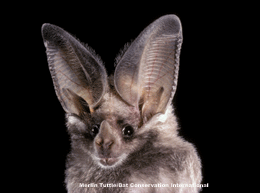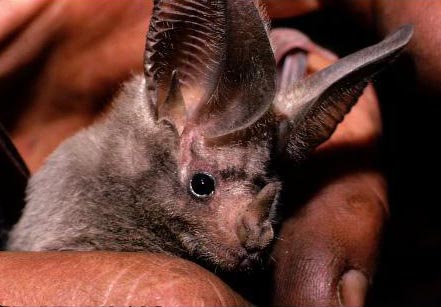Leaf-nosed bat
Big-eared Bat ( Macrotus californicus )
The leaf lobes ( Phyllostomidae ) are limited to America family of bats ( Microchiroptera ). It is a diverse, species-rich group, which comprises about 50 genera and 150 species. The best known are probably the vampire bats ( Desmodontinae ).
Dissemination
Journal noses are native to the tropical and subtropical regions of the Americas. Their range extends from the southern United States to northern Argentina in the place, including the West Indies with a.
Description
Named giving feature is available in most species nose leaf, which is used for directing ultrasonic sounds for echolocation. This has a simple lance-shaped structure and is easier to build than about in the Old World horseshoe bats ( Rhinolophidae ) or large sheet tabs ( Megadermatidae ). Other species have bump or wart-like structures on the chin. In species that feed on fruit or nectar, the nose leaf is regressed, these animals have instead developed pre-stretched snouts and long tongues. The animals from 26 to 32 teeth, which are shaped differently depending on the diet.
The size of the sheet tabs varies considerably, in addition to several very small species include the Large spear blade leading edge ( Vampyrum spectrum), with 200 grams weight and 90 centimeters wingspan one of the greatest bats ever to this group. The coat of most species is reddish, gray or brown in color, but there is also a white kind, the white bat ( Ectophylla alba); In addition, several species have white stripes on the back or on the face.
Way of life
Journal noses inhabit a variety of habitats, from rainforests to deserts. Most species are nocturnal, sleeping places serve them as caves, crevices, Tierbaue, hollow tree trunks, but also man-made dwellings such as mines, tunnels or buildings. Some species also build tented shelters made of large leaves. Many species sleep in large groups, some alone. Some species in cooler areas hibernate, others migrate during the winter months in warmer areas.
Food
Journal noses have diverse eating habits. Many species are insectivores, some larger species also eat small vertebrates. Others take nectar or pollen and play an important role in the fertilization of plants, others eat fruit. There are also omnivorous species. A unique among mammals eating habits have developed the vampire bats that only taking in blood.
Reproduction
Most species bring once a year, a single young is born. Delayed implantation, as observed in other bats, it should not exist in the sheet tabs.
System
Despite many studies, the classification of sheet tabs is not yet fully understood. Eight subfamilies can be distinguished:
- Vampire bats ( Desmodontinae )
- Lanz noses ( Phyllostominae )
- Fruit Vampire ( Stenodermatinae )
- Short-tailed leaf lobes ( Carolliinae )
- Antilles fruit Vampire ( Brachyphyllinae )
- Antilles Blossom bats ( Phyllonycterinae )
- Lonchophyllinae
- Flower bats ( Glossophaginae )
Other classifications are based on only four subfamilies, in this concept, the short-tailed leaf lobes ( as Carolliini ) the fruit of vampires and the Antillean fruit Vampire ( as Brachyphyllini ), the West Indies - flower bats (as Phyllonycterini ) and the Lonchophyllinae (as Lonchophyllini ) associated with the flower bats.
Phylogenetically are the vampire bats against the other sheet tabs that relationships can be represented in the following diagram:
Lanz noses ( Phyllostominae )
Fruit Vampire ( Stenodermatinae )
Short-tailed leaf lobes ( Carolliinae )
Antilles fruit Vampire ( Brachyphyllinae )
Antilles Blossom bats ( Phyllonycterinae )
Lonchophyllinae
Flower bats ( Glossophaginae )
Vampire bats ( Desmodontinae )










